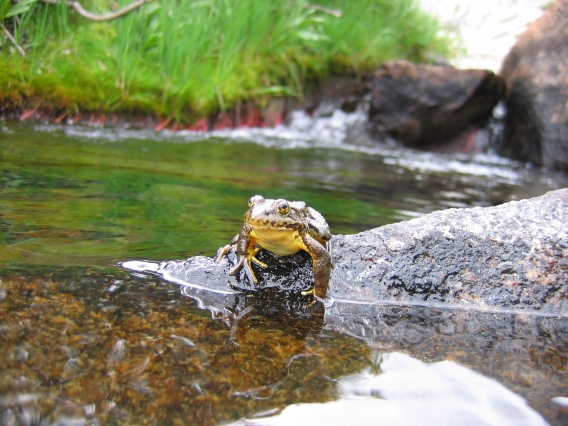Pathogen
leads to dehydration, other ill effects
 The fungal infection that killed a
record number of amphibians worldwide leads to deadly dehydration in frogs in
the wild, according to results of a new study.
The fungal infection that killed a
record number of amphibians worldwide leads to deadly dehydration in frogs in
the wild, according to results of a new study.
High levels of an aquatic, chytrid
fungus called Batrachochytrium dendrobatidis (Bd) disrupt fluid and electrolyte
balance in wild frogs, the scientists say, severely depleting the frogs' sodium
and potassium levels and causing cardiac arrest and death.
Their findings confirm what researchers
have seen in carefully controlled lab experiments with the fungus, but San
Francisco State University biologist Vance Vredenburg said the data from wild
frogs provide a much better idea of how the disease progresses.
"The mode of death discovered in
the lab seems to be what's actually happening in the field," he said,
"and it's that understanding that is key to doing something about it in
the future."
Results of the study are published today
in the journal PLoS ONE.
"Wildlife diseases can be just as
devastating to our health and economy as agricultural and human diseases,"
said Sam Scheiner, NSF program officer for the joint National Science
Foundation-National Institutes of Health Ecology and Evolution of Infectious
Diseases program, which funded the research.
At NSF, the Directorates for Biological
Sciences and Geosciences support the program.
"Bd has been decimating frog and
salamander species worldwide, which may fundamentally disrupt natural
systems," said Scheiner. "This study is an important advance in our
understanding of the disease--a first step in finding a way to reduce its
effects."
At the heart of the new study are blood
samples drawn from mountain yellow-legged frogs by Vredenburg and colleagues in
2004, as the chytrid epidemic swept through California's Sierra Nevada
mountains.
"It's really rare to be able to
study physiology in the wild like this, at the exact moment of a disease
outbreak," said University of California, Berkeley ecologist Jamie Voyles,
the lead author of the paper.
Unfortunately, it is a study that can't
be duplicated--at least not in the Sierra Nevada.
Frog populations there have been
devastated by chytrid, declining by 95 percent after the fungus was first
detected in 2004.
"It's been really sad to walk
around the basins and think, 'wow, they're really all gone,'" Vredenburg
said.
The chytrid fungus attacks an
amphibian's skin, causing it to become up to 40 times thicker in some
instances.
Since frogs depend on their skin to
absorb water and essential electrolytes like sodium from their environment,
Voyles and her colleagues knew that the fungus would disrupt fluid balances in
the infected amphibians.
But they were surprised to find that
electrolyte levels were much lower than anticipated. "It's clear that this
fungus has a profound effect in the wild," Voyles said.
Scientists want to learn as much as they
can about how the fungus affects wild amphibians, with the hope that these
findings will lead to better treatments for the infection.
"The chytrid fungus is causing
these frogs to become severely dehydrated, even though they are literally
surrounded by water," said Cheryl Briggs, a University of California,
Santa Barbara biologist and co-author of the paper.
The new study suggests that individual
frogs being treated for the infection might benefit from having electrolyte
supplementation in the advanced stages of the disease.
 Researchers like Vredenburg already are
experimenting with different ways of treating individual frogs, such as
applying antifungal therapies or inoculating the frogs with
"probiotic" bacteria that produce a compound that kills the fungus.
Researchers like Vredenburg already are
experimenting with different ways of treating individual frogs, such as
applying antifungal therapies or inoculating the frogs with
"probiotic" bacteria that produce a compound that kills the fungus.
"The disease is not very hard to
treat in the lab with antifungals," Vredenburg said. "But in nature,
the disease is still a moving target."
It is still unclear exactly how chytrid
spreads across a region, and which frogs might be susceptible to re-infection
after treatment.
Earlier this year, Vredenburg and
colleagues showed that a common North American frog might be an important
carrier of the infection.
The chytrid fungus has killed off more
than 200 amphibian species across the globe, but Voyles said the research
offers "a glimmer of hope that it might be possible to do something to
mitigate the loss."
Other co-authors of the paper are Tate
Tunstall and Erica Bree Rosenblum of UC Berkeley, and John Parker of University
of California, San Francisco.
-NSF-






No comments:
Post a Comment